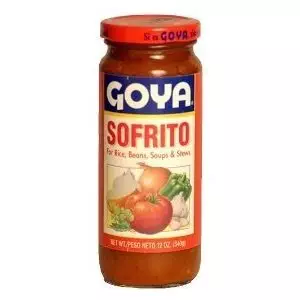Hey Foodies! This
month instead of doing the Foodie Fitness Corner, I’m handling the recipe of
the month.
month instead of doing the Foodie Fitness Corner, I’m handling the recipe of
the month.
Long story short: I recently had surgery on my leg and I’m limited
in activity. So rather than bore you all with my attempts at exercising within
my doctor’s limits, I thought I’d put on my chef hat and bad Julia Child’s
accent and share my sofrito recipe with you all.
in activity. So rather than bore you all with my attempts at exercising within
my doctor’s limits, I thought I’d put on my chef hat and bad Julia Child’s
accent and share my sofrito recipe with you all.
Now I know what you all are thinking, “What the HELL is
Sofrito?”
Sofrito?”
Those of you who have read Bariatric Foodie for a while have
seen this ingredient mentioned many times in Nik’s cooking. Whenever Nik uses this ingredient in her
cooking, there are usually a few comments of the blog along the lines of “what
is that?” and “where can I purchase that?”
Well, I’m here with a Foodie two-fer — I’m going to break down the
basics of Sofrito and then also share with you all how I make my own!
seen this ingredient mentioned many times in Nik’s cooking. Whenever Nik uses this ingredient in her
cooking, there are usually a few comments of the blog along the lines of “what
is that?” and “where can I purchase that?”
Well, I’m here with a Foodie two-fer — I’m going to break down the
basics of Sofrito and then also share with you all how I make my own!
Those of you that have never heard of sofrito may have heard
of its many cousins in other types of cuisine.
For example:
of its many cousins in other types of cuisine.
For example:
- People in Louisiana might know it as the “holy
trinity” - In Italian cooking it’s called soffrito
- The French call it mirepoix
- It’s known as refogado in Portuguese, epis in Haitian cuisine and
ginisá in Filipino cuisine, and suppengrün in Germany.
(I bet you didn’t know you were going to get a global culture lesson in
there too. Three-fer!)
there too. Three-fer!)
What all these things have in common is that they are basic cooking bases
that are used in each type of cuisine for stews, soups, rice and several other
types of dishes. Sofrito (that Nik uses
and what I’m going to show you have to make) just happens to be the
Latin/Hispanic/Caribbean version of this cooking base.
that are used in each type of cuisine for stews, soups, rice and several other
types of dishes. Sofrito (that Nik uses
and what I’m going to show you have to make) just happens to be the
Latin/Hispanic/Caribbean version of this cooking base.
While there’s lots of variations on sofrito, generally it consists of
garlic, onion and tomatoes and can be cooked in olive oil. From there you can
add lots of things based on what you like. Some folks add sweet or hot
peppers, herbs (like bay leaves, cumin, thyme and parsley). Sofrito is also a
great recipe to use for those veggies and herbs that are “on their way home”
(almost spoiled but not quite there yet).
garlic, onion and tomatoes and can be cooked in olive oil. From there you can
add lots of things based on what you like. Some folks add sweet or hot
peppers, herbs (like bay leaves, cumin, thyme and parsley). Sofrito is also a
great recipe to use for those veggies and herbs that are “on their way home”
(almost spoiled but not quite there yet).
I’m all about limiting food waste, so when I have veggies reaching that
point, I whip out my food processor and make some sofrito. It freezes well and
it really does give your savory recipes that extra something.
point, I whip out my food processor and make some sofrito. It freezes well and
it really does give your savory recipes that extra something.
So without further adieu, here’s my sofrito making method in four easy
steps:
steps:
Step
One: Gather your veggies.
Look at how sad
and wilted they seem! Check out that
poor bell pepper…it was on its last leg.
And one of those tomatoes had a bad spot I had to cut out. Not picured
here are the two heads of garlic I also used.
Step Two: Chop!
Here are my veggies all chopped up and ready to
be made into sofrito.
be made into sofrito.
Step Three: Mix it up!
Throw your
veggies into the food processor and pulse a few times until they start to
resemble chunky salsa.
veggies into the food processor and pulse a few times until they start to
resemble chunky salsa.
Step Four: It’s in the bag!
Or at least it will be once you put it
there. I portion it out into small
Ziploc snack size baggies and then put them all into a freezer bag and toss it
into the freezer. When I’m ready to use
it, I grab a bag and toss the whole thing in still frozen. It works great!
there. I portion it out into small
Ziploc snack size baggies and then put them all into a freezer bag and toss it
into the freezer. When I’m ready to use
it, I grab a bag and toss the whole thing in still frozen. It works great!
Sofrito is a time and money saver. So I encourage you to try your hand at making this great cooking base. If you have any questions, feel free to send them my way at bariatricfoodie@yahoo.com with the subject line “Sofrito.”
Until next month, Foodies!
This month we asked our Foodie News contributors about their guilty pleasures. Hillery’s? Nail polish! She reports owning over 300 bottles. From Nik’s experience of having hung out with Hillery in person, this reads more like an obsession but…who are we to judge!
Got a fitness (or, apparently, sofrito) question for Hillery? Hit her up at bariatricfoodie@yahoo.com!
 Bariatric Foodie Play with your food
Bariatric Foodie Play with your food








I make my own sofrito too! I freeze mine in ice cube trays. It’s so versatile. My recipe is a Puerto Rican version.